Forest & Shade Tree – Insect & Disease Conditions for Maine
June 21, 2024
Angelo Palome is splitting his time as a student intern between the Forest Protection Division doing GIS work and helping out with various tasks in the Forest Health and Monitoring (FHM) Division. Angelo is a May 2024 Bachelor of Science graduate from the School of Ecology and Environmental Science and Earth and Climate Science at the University of Maine Orono. His work with FHM will be primarily in support of forest pathologist Aaron Bergdahl. However, he will have a chance to help with a wide variety of projects relating to forest health. We are grateful to Forest Protection Division Specialist Dan Perkins for recognizing the opportunity to work together and look forward to Angelo’s continued assistance.
Roman Meneghini was hired as the Washington County Entomology Technician for our Forest Inventory and Analysis unit, starting on May 22. Roman is a University of Massachusetts Lowell graduate and has his master’s degree in Applied Biology and his bachelor's degree in Biological Sciences.
Maine Forest Service Publishes 100th Anniversary Edition of “Forest Trees of Maine”
"The Department of Conservation’s Maine Forest Service announced the release of the centennial edition of its most popular publication, “Forest Trees of Maine.” The Maine Forest Service published the first edition of “Forest Trees of Maine” in 1908 as a small black and white booklet that detailed how to identify about 50 of Maine’s important trees. It was immediately popular with the public.
In celebration of the book’s centennial, the Maine Forest Service has completely revised the book, incorporating many changes asked for by the public over the years. The new book has over 250 color photographs of Maine’s trees in all four seasons as well as the traditional pen and ink line drawings from previous editions. The book also includes historic photographs from Maine Forest Service archives, illustrating Maine’s rich logging and forest products history."
2024 note: this edition is available to purchase from the Maine Forest Service and some retailers in the state.
Unlike 2023, the 2024 aerial survey season is off to a strong start. During the week of June 10, FHM’s aerial survey team attended a training in New York, accompanied by aerial surveyors from other forest health programs across the Northeast. Upon their return to Maine, flights immediately began to document some of the current events unfolding across Maine’s landscape. Most notably, we flew to northern Aroostook County to size-up the scale of the forest tent caterpillar outbreak, which began in 2022 and has continued into 2024. The core damage area spans from Caribou to Fort Kent, though there is certainly defoliation damage beyond that extent as well. It quickly became apparent that we would not be able to map all the damage in one flight, so we’ll head back north soon to cover some of the other areas we weren’t able to reach. While we don’t have an acreage estimate quite yet, it’s safe to say the damage area exceeds the roughly 30,000 acres of damage documented in 2023.
In northern Maine, it is clear that forest tent caterpillar prefers aspen, with no evidence of defoliation on other hardwood species immediately adjacent to fully defoliated stands. The aspen has recovered well after the past two seasons of defoliation, and we’ll hope the trend continues in 2024. Interestingly, we are learning of another area with forest tent caterpillar activity in northern Somerset County. In this scenario, the caterpillars are feeding on another preferred host, sugar maple. Unfortunately, many of the areas being affected are sugarbushes for maple syrup production. We are planning an aerial survey flight over this area in the near future and will continue to gather information as the situation continues to unfold.
Image: An example of extensive aspen defoliation by forest tent caterpillar in northern Aroostook County as seen from the air. Photo: M. Parisio, MFS
Now heading to the Midcoast, we also had the opportunity to document the extensive winter moth defoliation occurring on oaks, spanning a core area from West Bath to South Bristol. Winter moth has been a problem in this area for about a decade, with some areas seemingly affected worse than others in any given year. Damage in 2024 appears to be widespread and rather uniform across several of the peninsulas. This may appear this way because we have not had ideal survey conditions and timing over the past several years to capture peak damage, as we feel we have captured in 2024.
Image: An example of extensive oak defoliation by winter moth in southern Sagadahoc County as seen from the air. Photo: M. Parisio, MFS
The one constant of all aerial survey performed in 2024 so far is the universal discoloration of white pine from white pine needle disease. While this discoloration is still very visible from the air, unfortunately it does not show up well on a camera to share the extent with our readers. In terms of area though, this really is a statewide event, and all areas we’ve flown over appear to be affected to some degree. Also becoming more visible in 2024 are stands of beech affected by beech leaf disease, as many of them are failing to recover after several seasons of canopy loss. Finally, the one thing that has not been very visible so far is very much defoliation from browntail moth caterpillars. We still have a lot of ground to cover, but we think overall acreage of damage from browntail moth could be down again in 2024. You can learn more about the issues mentioned here in the articles below.
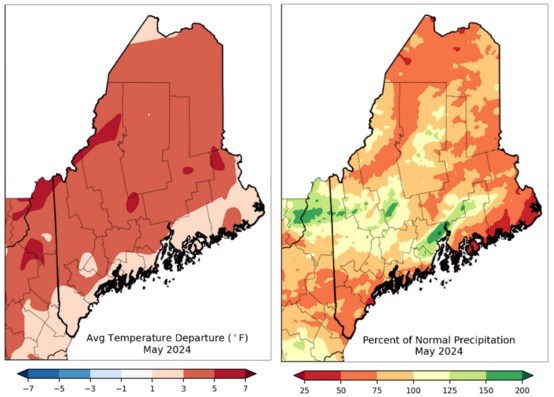 |
Image: The average difference in temperature in May 2024 compared to average normal temperatures from 1991-2020. Overall, the month of May 2024 was warmer than normal, with most of the state seeing a 3-5°F average increase in temperature (left). The percentage of normal precipitation compared to the normal precipitation from 1991-2020. Overall, the month of May 2024 was drier than normal for most of the state (right). Source: Northeast Regional Climate Center
The month of May 2024 was warmer than normal for Maine. NOAA reports the town of Caribou had the fourth warmest May on record. On average, the southern interior and northern climate divisions averaged 4-7°F higher than the 1991-2020 normal, which follows 12 consecutive months of record-breaking monthly average temperatures for the planet.
The last frost of the season occurred around May 10-12, with parts of the northern climate zone experiencing a handful of frosts later in the month. In May 2023, many parts of the state experienced a severe and later than normal frost, causing damage to many oak and beech tree leaves.
Image: As of June 4, 2024, about 25 percent of the state is experiencing abnormally dry conditions, with a small section of northern Aroostook county under moderate drought. Sources: NDMC, NOAA, and USDA
The month of May 2024 was drier than normal for most of Maine. For much of the state, precipitation in May was only 50-90% of the average normal, however, some areas in Waldo, Somerset, Franklin and Oxford counties experienced up to twice the amount of precipitation compared to normal. Toward the end of May, unusually dry conditions were reported in northwest Aroostook County and in some northern points of Somerset and Piscataquis counties, estimating about 25% of the state as being abnormally dry. Comparatively, last year by the end of May, roughly 39% of the state was experiencing some form of drought. Dry weather can cause the soil to become dry, which may lead to water stress for trees, causing wilting or yellowing leaves. Although part of Maine is experiencing drought, this is not likely to increase or become more severe in the next three months. Dryness and drought will probably not expand across Maine before September, as three-month projections indicate above-average precipitation levels that will likely counter projections for above-average temperatures for most of the state this summer.
Browntail moth (Euproctis chrysorrhoea)
At our monitoring sites the caterpillars have nearly all pupated and there are just a handful of active caterpillars crawling around and feeding. In preparation for the next life stage, caterpillars will silk together leaves, creating a packet. There can be more than one caterpillar in each pupal packet with some having five or more individuals inside. Caterpillars will pupate in many different locations including the foliage of host plants, sheltered areas on buildings such as roof overhangs, siding and decks but also vehicles, where they pose a risk of hitchhiking to new areas. To prevent spreading browntail to new areas, check car, trailers, RVs ,etc., for caterpillars and cocoons that may be trying to hitch a ride.
The silky cocoons/packets surrounding the pupae contain the last cast skin of the caterpillar and are full of toxic hairs. People in areas with browntail moth populations should take precautions to minimize exposure to the caterpillars’ hairs. Use protective measures to avoid skin contact with the toxic hairs when carefully removing caterpillars or cocoons. You can eliminate caterpillars and cocoons by moving them to a plastic bag or container, then freeze them or soak them in a bucket of soapy water before disposing of them in the trash or in the woods far from the house.
Pupation means we will soon see browntail moth flights. Nearly every year, we receive the first reports of adult moths sometime during the last week of June or first week of July. Usually, the peak of browntail moth adult activity is somewhere in mid-July and the last flights are toward the end of July and early August. Although some moths stick close to where they developed, others can travel long distances. Maine is home to many white moths that are active during the summer, the chart below can be used to tell the most common lookalikes apart from browntail moth.
Image: Side by side comparison of three common browntail moth lookalikes and browntail moth.
To reduce the attractiveness of your landscape to these travelers, limit outdoor lighting in July. If you can’t eliminate lighting, consider switching to yellow-spectrum lights. Research by the Mech Lab at the University of Maine indicates that these yellow-colored lights are less attractive to browntail moth. Preliminary results from the lab also indicate that higher density browntail caterpillar populations develop near lights. Limit the use of lights to have a better spring next year.
We continue to see mortality at some of our monitoring sites and other areas including Bradley, Brunswick, Old Town, Orono, Richmond, Dresden, and Turner. Through public reports, we have also been able to confirm diseased caterpillars in Belgrade, Durham, Freeport, Leeds, Swanville, and Waterville. Although we are seeing some diseased caterpillars, it should not be assumed this will lead to a widespread die-off of browntail caterpillars. More typically, the fungus or virus may be able to spread in localized areas, like the population on a tree or a cluster of trees.
Image: Fungal killed browntail moth caterpillars at sites in Dresden, Brunswick and Turner, ME. Photos: T. Schmeelk, MFS
In addition to the pathogens, browntail has other natural enemies in the environment, both specialists and generalists. Predatory stink bugs, spiders, hornets, ground beetles and other insects have been observed feeding on browntail moth caterpillars. Some of the specialists include the parasitoid fly Townsendiellomyia nidicola. Karla Boyd’s thesis work at UMaine involved the parasitoid community surrounding browntail moth, and in addition to T. nidicola she recorded at least three other parasitoid flies with varying degrees of specificity. Karla also recorded a few parasitoid wasps that attack browntail caterpillars, including species in the genera Pimpla and Theronia. Last week, we observed parasitic wasps probing pupal cocoons at some of our monitoring sites.
Birds are also considered natural enemies of browntail moth, however, many birds will not eat them, especially the larger caterpillars, as the hairs are a defense against vertebrate predators. In Paul Schaefer’s 1974 dissertation, which is one of the most in-depth papers on browntail moth, he reports 32 bird species as predators of browntail in North America; however, he did not observe predation by birds in his PhD work in Maine and Massachusetts. Two species of cuckoo can be found in Maine, both black and yellow-billed. These birds specialize in eating fuzzy caterpillars and were reported to have been abundant in 2020, also coinciding with plentiful populations of eastern tent caterpillar, fall webworm, spongy moth, and browntail. It is to be noted that natural enemies are not effective at controlling browntail populations when in outbreak status.
Sign up for our Browntail Moth Updates for monitoring reports and to stay informed about this insect.
Eastern Phantom Crane Fly (Bittacomorpha clavipes)
While in the field, staff have been noticing more of these interesting flies. The adults can be found from spring to early autumn around the edges of wetlands around shaded thick vegetation. There are two species in this genus in North America, one on either side of the Rocky Mountains. What gives phantom crane flies their ghost-like appearance in flight are enlarged tarsi (last segment of the legs) which contain air sacs which help them almost float through the air. This effect is further enhanced by the black and white coloration which in the dappled light habitat where these flies occur, and they look as if they are appearing and disappearing in patches of light and shadow. Many insects that have this black and white coloration are advertising they are not palatable, but in this case they are likely using it as camouflage from would-be predators that could eat these slow-moving flies. The larvae are aquatic and equipped with a retractable siphon that helps them live in low- oxygen environments. The larvae are important in nutrient cycling as they feed on organic debris in the water, helping break it down, making nutrients available again.
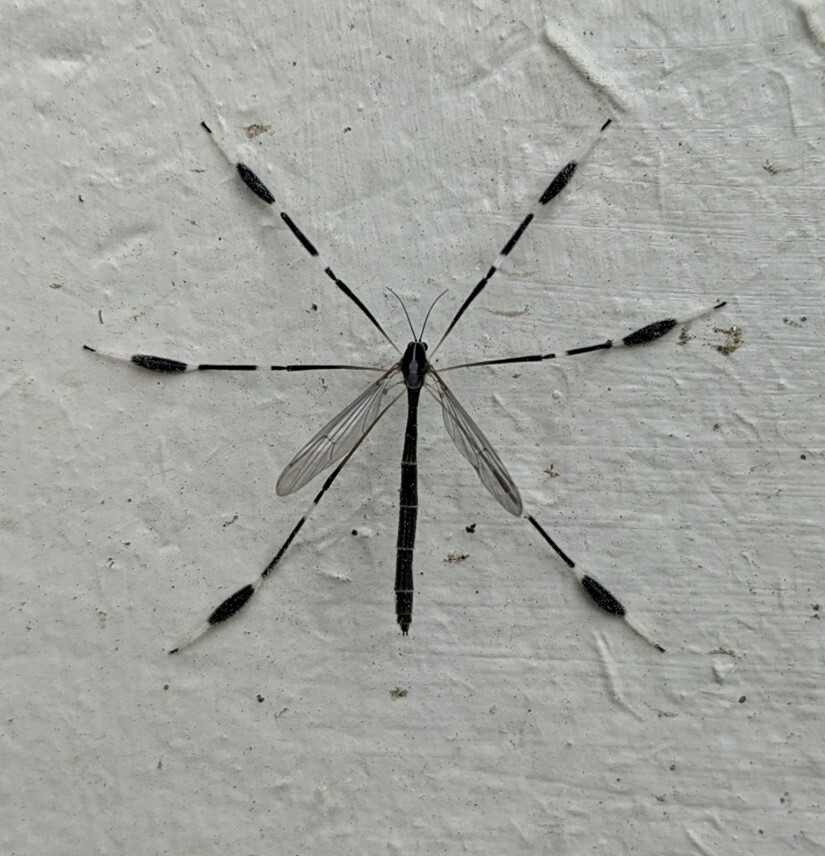 |
Image: Phantom crane fly resting on the side of a building, Dresden, ME. Photo: T. Schmeelk, MFS
Forest Tent Caterpillar (Malacosoma disstria)
Forest tent caterpillars are back in force once again in the state of Maine. Despite their name, this species does not actually make the conspicuous webbed tents seen in trees, but the effect of their feeding has become quite dramatic in certain parts of the state. In the north, the most significant defoliation has been centered around Caribou, Limestone, and Fort Fairfield, with caterpillar populations observed near Cary Medical Center and Loring Air Force Base. Further north, Fort Kent and Van Buren are also affected, though populations here appear patchier and areas of the valley west of Fort Kent appear to be relatively quiet.
Several public reports and field crew observations have also turned up a patch of activity in northwestern Maine near the St. Aurelie border station. In this area, when aspen became unavailable through feeding or was absent, the caterpillars moved onto sugar maple. By mid-June, sugar maple in some areas were reported to be around 50% defoliated. This region is home to large commercial sugarbush leases. High rates of defoliation in a single year may impact volume and sugar content of sap collected for sugaring and multiple years can significantly affect stand health.
Pockets of completely leafless aspen have ranged from half an acre to upwards of 20 acres, with the moving front appearing to spread further west day by day. Refoliation has begun in some areas, though time will tell if multiple seasons of feeding will have lasting effects on the trees. In their analysis of forest tent caterpillar outbreaks in Eastern Canada, Cooke et al. (2009) suggested that fragmented forests, such as those seen in northeastern Aroostook County, are more likely to sustain longer outbreaks of forest tent caterpillar resulting in higher rates of tree mortality.
Aside from the ecological effects, large aggregations of the caterpillars themselves have also been observed marching across the landscape. Business storefronts have suddenly become home to hundreds of fuzzy loiterers and drivers are understandably cautious on roads which have become slick with flattened caterpillars. Despite how unappealing these conditions may be, it is important to note that these large aggregations are both temporary and completely natural. Forest tent caterpillars are a species native to Maine which serves as an important food source to many other wildlife species, and fortunately do not cause the same irritable rashes as the invasive browntail moth caterpillar.
Similar to the cicada swarms currently occurring in the Midwest, these population booms are a spectacle to marvel at, one many people will never be able to experience for themselves. While intervention is not necessarily required in all circumstances, residents who would like to take a responsible approach to managing forest tent caterpillars are encouraged to read more in our recent caterpillar bulletin.
Image: Large scale defoliation of aspens near Caribou, ME. Photo: K. Draper, MFS
Maple Twig Borer (Proteoteras aesculana)
While on a site visit with a landowner, a maple tree with dead branch tips was observed. The cause of the tip dieback was determined to be maple twig borer. The caterpillars hollow out a twig and feed on the tissue, petioles, and seeds from within causing the leaves to die back and droop down. This feeding strategy is partially to avoid predation from birds as well as parasitic wasps and flies. Maple twig borer is native and can be found throughout Canada and the United States where its host plants also occur. As its common name implies, its primary hosts are maples, however it also occurs on buckeye (the source of its species name) and occasionally apple. Caterpillar feeding is typically finished towards the end of June with adult moths being present in July and August. Since it is native and thus has its own natural predators and controls, management is typically not warranted.
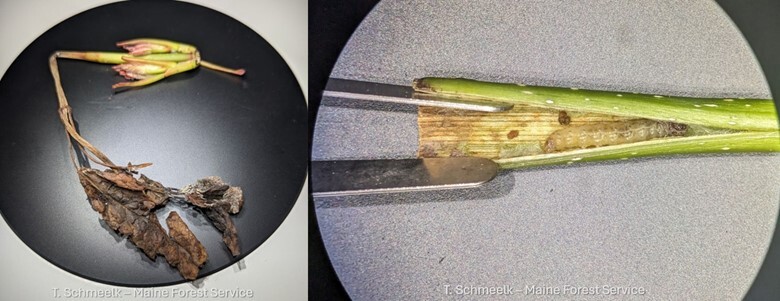 |
Image: Tip damage on maple twig and a mature caterpillar in its larval chamber under magnification. Photos: T. Schmeelk, MFS
Spruce Budworm (Choristoneura fumiferana)
As uncovered by the spruce budworm (SBW) monitoring program in 2023, there is currently an area along the Quebec border in northern Aroostook County with elevated SBW populations. In between outbreaks, SBW larvae are present but typically very difficult to find. We’ve been looking for SBW everywhere we hang SBW monitoring traps in Maine, with little luck locating larvae in most places. One of our field technicians recently took a field trip to the area of greatest concern however, and below are the field notes:
“Every stop that I made I was able to find numerous larvae in the lower crowns of both balsam fir and white spruce. Larvae was easily found in all trees ranging from sawlogs to saplings. I did not notice much feeding damage as they are currently feeding in the new leaves. I noticed larvae of different sizes and possible different instars. It was alarming to me as to how easy it was to find larvae and also the amount that were in each sample. I surveyed along the Escourt road from mile 18 to mile 29 and was able to find SBW at every stop. Mile 19 to mile 24 seemed to have the highest numbers. It will be interesting to see how much damage will be done once they are finished feeding.”
Image: The tips of a fir branch showing feeding damage from SBW larvae and two visible larvae that have emerged from their hiding places after being disturbed during sampling. Photo: J. Bither, MFS
We will continue to keep a close eye on this area and the landowners are well-aware of the situation at hand. Given the high number of larvae, it could be possible to view SBW damage during aerial survey in 2024, though we feel it will still be difficult at these levels. Once any SBW feeding has had a chance to become discolored, we’ll see what we can find.
Winter Moth (Operophtera brumata)
We have received many reports of severe winter moth defoliation from Phippsburg and Georgetown as well as the surrounding area including Boothbay Harbor, West Bath, and Bristol. This was confirmed during our aerial survey last week. This area of Maine has been under intense winter moth pressure for several years now. We are continuing releases of the parasitic fly Cyzenis albicans in that region of Maine The goal is to bring winter moth into equilibrium with the rest of our native insect fauna so that it doesn’t outbreak or doesn’t outbreak as severely.
Each year we collect winter moth caterpillars from our previous biocontrol sites to obtain more C. albicans for new release sites along the coast. On Wednesday, May 29, field staff with help from our collaborators at University of Massachusetts Amherst collected over 9,237 caterpillars from five sites. The following week a smaller group spent two days collecting an additional 3,784 caterpillars at five sites further north along the coast where development was delayed. Two of those sites, Lubec and Mount Desert Island, are not previous release sites for C. albicans as we wanted to see if any Cyzenis would be detectable in these populations far from our release sites.
Images: Annual winter moth caterpillar collection performed by field staff. Photos: T. Schmeelk, MFS
Anthracnose Diseases
In early June, the insect and disease lab received a report of numerous dark lesions and early defoliation of red maples. The report included pictures of black lesions on leaves, symptoms suggestive of maple anthracnose which can be caused by Aureobasidium apocryptum, Discula campestris and Colletotrichum gleosporoides in our region. However, it seemed a bit early for such severe anthracnose symptoms, so we conducted a site visit. Inspecting the impacted trees, symptoms existed more or less evenly throughout the crowns. Lesions were amorphous or v-shaped as is typical with maple anthracnose. After taking some samples, incubating them in moisture in the lab and viewing the spores produced on small football-shaped structures on the leaf veins and petioles (called acervuli), maple anthracnose was confirmed.
The fungus that causes maple anthracnose overwinters on buds and causes lesions on leaves as they emerge in spring. This can lead to coalescing of lesions, resulting in an almost scorched appearance and early defoliation if disease loads are high. There are several other species of anthracnose that are specific to the tree species they like birch anthracnose, maple anthracnose, ash anthracnose, etc. Due to the cool and very wet weather in June 2023, conditions perfect for anthracnose diseases’ development and build-up, symptoms were widespread across susceptible species last year. This meant that by the end of the 2023 growing season there was plenty of overwintering inoculum for infections this spring – which is what we have been seeing so far in 2024. Last week, the lab received samples and reports of ash anthracnose, birch anthracnose, maple anthracnose and oak anthracnose causing damage in various parts of Maine.
Anthracnose symptoms can look very serious, but as long as an infected tree maintains roughly half of its leaf area in good health, they tend to be fine, despite less-than-ideal aesthetics. If trees defoliate due to heavy infection, supplemental fertilizer can be applied to compensate for lost resources.
Images: (upper right) Dark lesions caused by oak anthracnose (Apiognomonia errabunda) also coalescing to cause severe leaf deformation; (middle) Dark lesions cause by maple anthracnose (most likely Aureobasidium apocryptum); (right) Circular lesions on river birch leaves caused by birch anthracnose (various species possible in the genera Colletotrichum, Cryptocline, Marssonina and Ophiognomonia); (bottom left) Heavily infested and defoliated red maple leaves with a scorched appearance due to heavy infestation by maple anthracnose; (bottom right) Ash leaves with a mild level of ash anthracnose (Gnomoniella fraxini) infection. Photos: A. Bergdahl, MFS
Beech Leaf Disease (Litylenchus crenatae mccannii)
As the season has progressed from south to north, reports of beech leaf disease (BLD) have been increasing. Some reports have been within or near towns already known to be infested, but also new towns well beyond infested areas have been reported. A total of 57 new town detections (as of 6/21) have been confirmed so far in 2024 and BLD is now found in 15 of Maine’s 16 counties. Check for current information and distribution maps of BLD in Maine on the Maine Forest Service BLD website. There you can also find an FAQ on BLD and other information about the disease and its impacts.
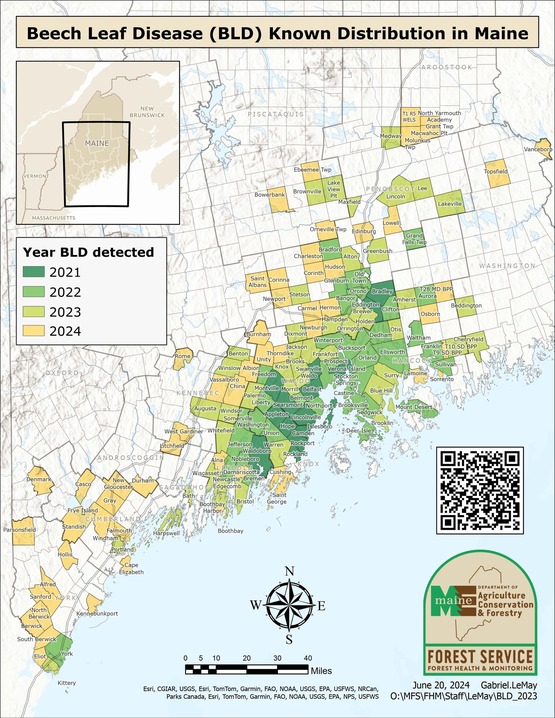 Beech Leaf Disease Winter Bud Survey Trial
This winter the MFS conducted a bud survey to monitor for beech leaf disease caused by the nematodes Litylenchus crenatae mccannii. Their characteristic feeding damage in the buds of American Beech (Fagus grandifolia) was demonstrated in research by Paulo Viera (2023) and was the basis for this effort. For our survey, at least 15 buds were collected from a minimum of five trees at every site, which were then brought back to the lab and dissected and analyzed by technicians under a microscope. A total of 79 towns were surveyed, with some towns having more than one sample site. Of these, 14 towns were identified as positive for BLD based on the presence of nematode activity observed in the bud samples, whereas samples from 62 towns were recorded as negative. Further evaluation and ground truthing of surveyed sites early this field season yielded four false negatives (zero false positives), suggesting that to detect trace infestations a larger number of buds might have to be collected and dissected. All in all, we believe this trialed survey proved promising in enhancing our ability to detect beech leaf disease nematode damage outside of the summer field season and as an efficient add-on to winter survey duties and could allow us to monitor for early infestations as this disease continues to spread.
 |
Images: (left) Nematodes seen in the bud scale of a winter bud (in yellow circles); (right) Up-close view of a BLD nematode (Litylenchus crenatae mccannii) isolated from an American beech (Fagus grandifolia) bud in winter. Photos: A. Karter, MFS
Images: A comparison of beech bud scales without nematodes and those with characteristic damage associated with nematode feeding inside the bud. Photo: A. Bergdahl, MFS
Bleeding canker (Phytophthora spp.)
A report of bleeding cankers at the base of a beech tree in Hancock County in spring led to a site visit and the potential identification of a species of Phytophthora. There are several species in the genus Phytophthora that can cause damage to trees, including the fungus that causes sudden oak death (Phytophthora ramorum) which has not been found in Maine and should not be confused with oak wilt, which also has not been found in Maine.
Phytophthora species thrive in wet conditions and typically first infect host trees through wounds in roots. The spores of Phytophthora spp. are attracted to chemicals given off by wounded plant tissues and they are actually mobile in water (the spores are equipped with small tails that allow them to ‘swim’ to specific areas to cause infection). Spores of the fungus may be further spread to parts of the lower stem via rainsplash where bleeding cankers form, killing vascular tissues under the bark. Sometimes Phytophthora spp. can be brought to new sites on nursery material, which may have occurred in this case. Some planted rhododendrons (also highly susceptible to infection by Phytophthora spp.) had died and been removed in the previous year, just uphill from this frequently irrigated landscape (like most of Maine in 2023, this area also experienced frequent rainfall). Presumably spores traveled in water films to infect this European copper beech.
Infections by Phytophthora spp. are often serious threats to tree health and managing this disease can be challenging and is usually reserved for high-value trees. There is some evidence that phosphite products applied as trunk drenches in spring are effective in treating Phytophthora spp. infections. An additional fall application may enhance management. Consulting a certified arborist for more information about treatments for Phytophthora spp. is recommended.
Image: Bleeding cankers at the base of a European beech tree, a symptom typical of fungi in the genus Phytophthora that attack trees and shrubs. Photo: A. Bergdahl, MFS
White Pine Needle Damage
The impacts of the white pine needle damage disease complex (WPND) became apparent in late May throughout the white pine resource in Maine with symptom development seeming to be a few weeks early this year. Disease symptoms include yellowing and shedding of second-year-and-older needles leading to discolored trees, heavy needle drop and very thin-looking crowns.
Reports from the public, natural resource professionals, MFS staff and MFS aerial survey results indicate the disease complex is impacting Maine’s entire eastern white pine resource. Similar observations have been reported regionally from MA, NH and VT. In Maine, the most commonly documented fungal species from the WPND disease complex is brown spot needle blight (Mycosphaerella dearnessii). Bifusella linearis, Dooks needle blight (Lophophacidium dooksii) and Septorioides strobi have also been documented causing WPND symptoms in Maine. The prevalence and distribution of these diseases vary and they can co-occur in the same stand, on the same tree and sometimes even on the same pine needle.
Due to the very wet June of last year (2023), it is not surprising to be receiving reports of severe WPND disease symptoms this year. The life cycle of the WPND diseases is such that after infection by one of the WPND fungi during wet weather in late May to early June, the fungus will grow within the needle throughout the year showing no symptoms until the following May or June. A this time needle will discolor and spore-producing structures will form on these needles that disperse large volumes of spores. Simultaneously, the white pines shed these disease-laden needles leading to accumulations of pine needles on roads, driveways, on roofs and in gutters. Spores from the WPND fungi will land on newly emerging needles, leading to new infections and completing the disease cycle. This is an altogether different phenomenon than the natural shedding of older needles. That typically occurs in healthy white pines in the autumn.
Recurrent defoliation, like that caused by WPND, is stressful to trees and may lead to attack by secondary agents of decline. This disease has been documented causing early defoliation since 2007 with symptoms ranging from mild to severe. Our observations in recent years are that WPND symptoms reliably develop even when we have fewer prolonged precipitation events in Mays and Junes of previous years. This may indicate that the WPND fungi need less water for spore dispersal and infection than once thought. However, the high level of disease this year would indicate that ample precipitation during the period of infection during spore dispersal in the previous year certainly seems to favor disease development and severe symptoms that have certainly caught the attention of many this year.
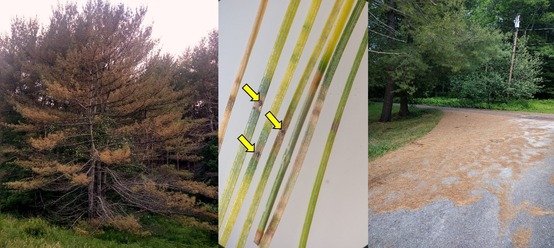 |
Images: (left) An eastern white pine tree showing severe symptoms of WPND; (middle) Banding and discoloration at the individual needle level showing the development of spore-producing structures (yellow arrows); (right) Needle accumulation on a driveway in June due to needle cast associated with WPND. Photos: A. Bergdahl, MFS
Canopy Disturbance: A Pathway for Invasive Plant Entry
For terrestrial invasive plants to become established, they often require an open area with available niche space and a nearby seed source. Therefore, undisturbed, closed canopy forests with high structural complexity (i.e., low available niche space) do not provide the open areas often required for establishment of invasive plants and are considered to have high biotic resistance to invasive plant colonization. However, in many of Maine’s forests, forest pests and disease (e.g., beech bark disease, beech leaf disease (BLD), and hemlock woolly adelgid) have significantly degraded both overstory and understory foliage - ultimately increasing the amount of light that reaches the forest floor. While canopy breaks are not uncommon in forested ecosystems, they are becoming more frequent and widespread with warming temperatures and novel threats. These large and frequent canopy breaks can lead to significant and lasting changes in forest structure, canopy closure, and species composition. Furthermore, trees that are impacted by pests and disease are more vulnerable to other stressors such as extreme weather and drought. As a result, these forests experience greater blow down occurrences. This creates additional canopy gaps and soil disturbance (i.e., bare, exposed soil) - and further increases forests’ vulnerability to invasive plant incursion.
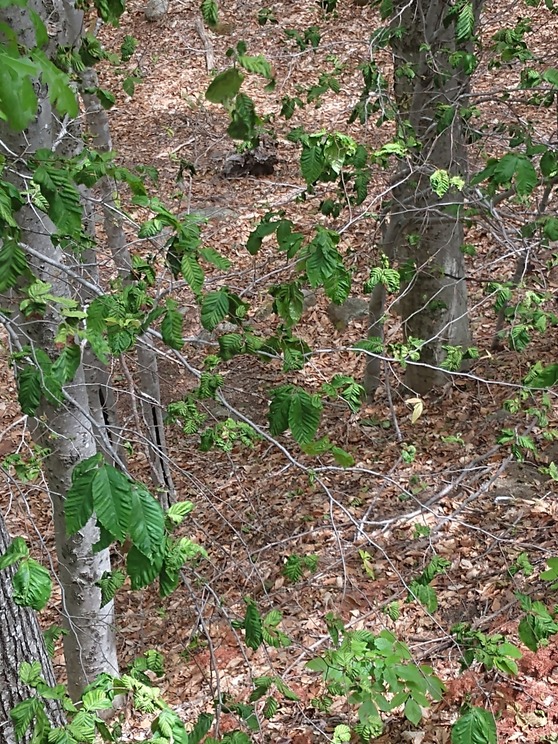 |
Image: Thin canopy of BLD-infected American beech tree. Photo: A. Bergdahl, MFS
Due to aggressive growth, extended leaf phenology, and long seed viability, an invasive seed source near these disturbed sites can quickly outcompete native species by exploiting gaps in the canopy and capitalizing on newly available light and resources. Therefore, early detection and rapid response is critical in these areas. It is important to know where invasive plant seed sources are located on the landscape and their proximity to a new or existing disturbance or forest health concern. Furthermore, monitoring and surveying a site for invasive plants after a disturbance or change in the canopy is crucial for the ability to remove them quickly – and preventing their establishment. As these (novel) pests and pathogens expand deeper into forests, invasive plants are able to invade areas once resistant to invasion. In addition, secondary dispersal of seeds via birds has allowed invasive plants to exploit canopy gaps without requiring close proximity to seed sources.
Please visit the Maine Natural Areas website under the Invasive Species tab to view our invasive plant field guide for identification tips, management/removal recommendations, invasive plants by habitat type, and to sign-up for a free iMapInvasives account to map and view the distribution of invasive species in your area.
Image: Forests impacted by diseases like beech leaf disease open up the canopy and allow more light to reach the forest floor, possibly making a more hospitable place for invasive species.. Photo: A. Bergdahl, MFS
Conditions Report No. 2, June 2024
On-line
Department of Agriculture Conservation & Forestry, Maine Forest Service – Forest Health and Monitoring
Contributors: Aaron Bergdahl, Amy Emery, Chad Hammer (with interns Grant Regan-Loomis and John Whittaker), Abby Karter, Gabe LeMay, Mike Parisio, Brittany Schappach, Thomas Schmeelk and Andy Whitman
|